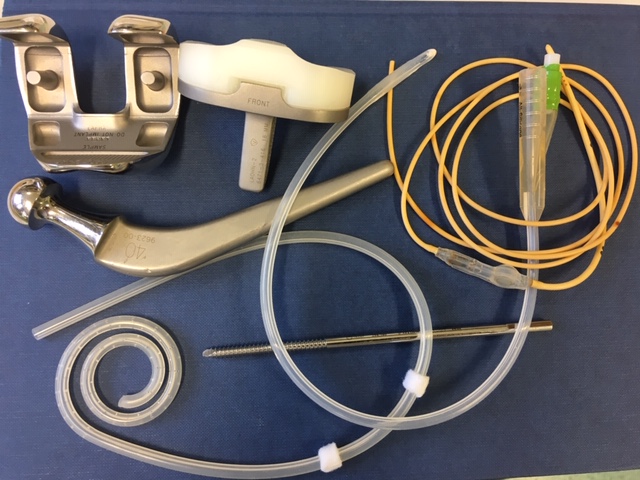Reducing infections worldwide with antimicrobial hydrocephalus shunts

Hydrocephalus (a condition causing fluid on the brain not being able to escape) raises pressure inside the head and can cause brain damage if the condition is not promptly treated. Normally a piece of equipment known as a shunt- a thin tube with a valve, that is surgically implanted in the brain - is used to drain away the excess fluid to another part of the body. Unfortunately shunt treatment has a very high infection rate, which can lead to life-threatening illness and further brain damage.
Reducing infections for over 1,000,000 patients
Helping to revolutionise the treatment of this life-threatening medical condition, the technology was commercialised in 2003, as Bactiseal(R)catheters in partnership with neurosurgical device manufacturer, Codman, part of the Johnson & Johnson family of companies (now Integra Life Sciences). The FDA-approved shunts are now widely used across 47 countries, reducing infection rates from 24.5% to 4.4% for over 1,000,000 patients (>170,000 since 2016)
A recent UK NIHR-funded randomised controlled trial (BASICS trial) has just reported a very significant reduction in brain infections using our shunt, compared to silver-coated ones that made no difference. Our newest neurosurgical device is designed to prevent serious infections due to gram negative bacteria that Bactiseal is unable to prevent
Reducing infection risk in people on kidney dialysis
The technology is currently in development for the catheters used by people on kidney dialysis, in collaboration with University Hospitals of Derby and Burton NHS Foundation Trust.
The CAP study (Clinical Evaluation, Development and Commercialisation of an Antimicrobial – Impregnated Catheter Against Peritonitis) is receiving funding from the NIHR Invention for Innovation Programme, and is being led by Professors Maarten Taal and Roger Bayston, with a team of experts at the University of Nottingham and University Hospitals of Derby and Burton NHS Foundation Trust.
Long-term urinary catheters and other devices
Further development of the technology is continuing, with applications in other devices and catheters at various stages of development.
The technology shows particular promise in improving the infection rates associated with
Using a similar technology platform and a tailored formulation our catheter retains activity against highly antibiotic – resistant bacteria for up to 12 weeks (the time when longterm catheters are usually changed). We have had very promising results from the first 30 patients trialling the technology. People with spinal cord injury, multiple sclerosis, stroke, dementia and other conditions are likely to benefit. After a i4i NIHR grant, we are now working towards a multicentre randomised controlled trial.
Fractures are often stabilised from the outside using a cage to which the broken bones are fixed with pins of wires inserted through the skin. We have developed a device that fits around the pins to reduce the infections around them, that can result in osteomyelitis (bone infection).
Bone cement polymer is often used as a vehicle for antibiotics that need to be administered in high doses locally, to where the infection is. This can give rise to a peculiar form of resistance (paradoxical resistance) discovered by us that usually goes undetected. We are investigating ways in which this resistance occurs and working out ways to prevent it. This will allow companies to optimise their antibiotic bone cements and will save patients from debilitating and dangerous bone infections.
Key papers
Roger Bayston, Leanne E. Fisher, Klaus Weber. An antimicrobial modified silicone peritoneal catheter with activity against both Gram positive and Gram negative bacteria Biomaterials 30 (2009) 3167–3173.
Bayston, R. (2017) 7.30 Cerebrospinal Fluid Shunts. In: Ducheyne, P., Grainger, D.W., Healy, K.E., Hutmacher, D.W., and Kirkpatrick, C.J. (eds.), Comprehensive Biomaterials II, vol. 7, pp. 612–627. Oxford: Elsevier.
Leanne E. Fisher, Andrew L. Hook, Waheed Ashraf, Anfal Yousef, David A. Barrett, David J. Scurr , Xinyong Chen, Emily F. Smith, Michael Fay, Christopher D.J. Parmenter, Richard Parkinson, Roger Bayston. Biomaterial modification of urinary catheters with antimicrobials to give long-term broadspectrum antibiofilm activity. Journal of Controlled Release 202 (2015) 57–64.
Katherine Belfield, Helen Betts, Richard Parkinson, Roger Bayston. A tolerability and patient acceptability pilot study of a novel antimicrobial urinary catheter for long-term use. Neurourology and Urodynamics. 2018;1–8. DOI: 10.1002/nau.23858
Experts
Professor Roger Bayston, Professor of Surgical Infection, Dr Katherine Belfield, Researcher in Surgical Infection
Related pages
Preventing infections - antimicrobial devices and coatings